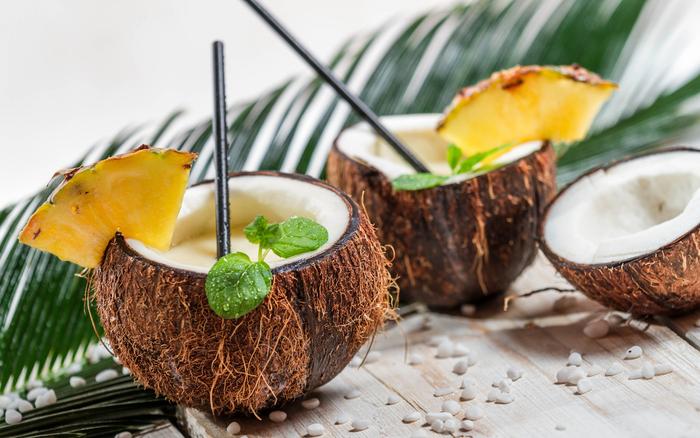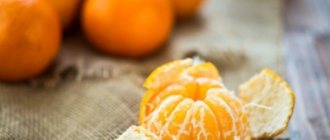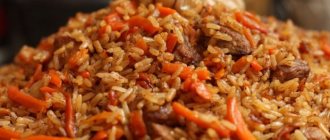How to properly consume coconut during lactation?
Very often, after giving birth, women have a question about whether coconut can be consumed while breastfeeding.
It contains a natural component such as lauric acid. Its composition is very similar to breast milk. Therefore, it is extremely rare for a young mother or baby to develop an allergy after consuming coconut during breastfeeding. Milk coconut is hypoallergenic. It consists of 95% water, which allows it to be quickly absorbed in the body.
The exotic liquid fully complies with dietary nutrition, so it can be safely consumed during lactation. If you follow the norm, then there will be no negative reaction from mother and baby.
A nursing woman can drink no more than 1 glass of coconut milk and eat 20-30 grams of coconut flakes per day.
It is best to start introducing coconut into your diet at 2 or 3 months of breastfeeding. First you need to take a small sip to observe the child’s subsequent reaction to the nutritional innovation.
If he does not have an allergic reaction and does not have stomach problems, then he is allowed to introduce the fruit into his menu on an ongoing basis.
If you observe negative signs, it is better to wait another 1 month and then try again.
A coconut allergy will manifest itself with the following symptoms:
- rash;
- redness;
- itching;
- peeling of the skin;
- digestive system disorder;
- irritation of the nose and throat.
When breastfeeding, a nursing mother is not always allowed to eat coconut. If she notices the first signs of an allergy, the product is immediately removed from the diet. After this, you need to visit a doctor so that the specialist examines the child and, if necessary, prescribes a course of treatment.
Coconut during breastfeeding: is it possible, benefits, harm
Coconut is a nutritious and valuable nut, but its benefits for breastfeeding women are questionable. And completely in vain. Coconut is a source of vitamins and microelements that can diversify the diet of a nursing mother. However, introduce it into your diet very carefully. Still, coconut can cause allergies in a child.
Coconut diversifies the diet of a nursing mother and enriches the body with vitamins, but it should be introduced into the diet carefully.
The benefits of "paradise nut"
Coconut contains a high content of calcium, iron, potassium, manganese, selenium and sodium, as well as vitamins B, C and E. It is especially important for a nursing mother to receive nutrients. During pregnancy, her body “shared” its reserves with the baby, and milk production is accompanied by additional consumption of microelements and vitamins.
Eating coconut during breastfeeding stabilizes hormonal levels, reduces cholesterol levels and improves blood composition.
So what benefits does regular coconut consumption provide to a young mother?
- Vision improves.
- Blood cholesterol levels are reduced.
- The functioning of the thyroid gland is normalized.
- Blood composition improves.
- The hair structure is strengthened.
- The skin takes on a healthy appearance.
- Maintains fluid balance in the body.
- Hormonal levels stabilize.
- Toxins and impurities are removed.
- Digestion improves.
- The tone increases.
- Your mood improves.
- Immunity is strengthened.
Coconut is the first assistant in weakening the body. It will help restore strength after serious physical activity. And childbearing is precisely such a burden.
Coconut helps restore strength to a woman after giving birth.
Coconut milk and coconut water - what's the difference?
Coconut water is the liquid inside young coconut palm nuts. As the fruit ripens, drops of oil fall into the liquid, thus forming coconut milk. But milk can also be obtained artificially - by mixing coconut water with crushed nut pulp.
The main difference between the two drinks is the calorie content. 100 g of coconut water contains only 18.9 kcal, while the same amount of coconut milk contains 229.9 kcal. As you can see, the difference is significant. Breastfeeding women who are overweight prefer a more dietary drink. Coconut water contains fewer vitamins and minerals per unit volume, but it perfectly tones and quenches thirst. This is truly a feminine product. Thanks to its ability to reduce acidity in the body, coconut water prevents the appearance of “orange peel” in interesting places, improves the condition of the skin, hair and nails.
Coconut milk is a storehouse of vitamins and microelements during lactation, but you should not abuse it. After all, adding kilograms is of no use to you. However, for those who cannot tolerate animal protein, this drink is a must. After all, milk from a tropical nut is not inferior in its characteristics to its animal counterpart - cow's milk.
In terms of the composition of electrolytes, coconut water is close to blood plasma, and thanks to its sealed “packaging” it is sterile. Military field doctors took advantage of this property during the Vietnam War, successfully using the “paradise drink” for blood transfusions.
Coconut milk contains many beneficial substances, but due to its high calorie content, it can lead to weight gain.
Pulp and shavings
Coconut flakes are the dried meat (copra) of a coconut. Its calorie content is 592 kcal per 100 g, with most calories coming from fat. The pulp contains 20 - 30% liquid, so its energy value is slightly lower.
Fatty acids, so necessary for the mother's body during lactation, are abundant in both the pulp and the chips. Dietary fiber helps cleanse the intestines of toxins and waste, healing the body. Remember that the shavings and pulp should be a uniform white color. Darkening indicates that the fruit used has been spoiled, or poor storage of the crushed product.
Coconut pulp promotes the production of breast milk.
Lauric acid, found in coconut, is the main fatty acid in breast milk. By consuming tropical nuts, a nursing mother can easily increase lactation.
Coconut is considered a non-allergenic food, but precautions are necessary. In the first months of life, an infant is especially susceptible to new foods that come to him through milk. If the mother did not eat coconuts during pregnancy, during breastfeeding you can introduce them into the diet at 3–4 months of the baby’s life.
Start with a small portion: two to three tablespoons of coconut milk or one teaspoon of shavings is enough for the first time. Try not to introduce new products into your menu at this time to make it easier to track allergic manifestations. If the baby’s health has not worsened in 2-3 days and his skin is clean, you can eat coconut daily. However, don't overdo it. Breastfeeding involves a gentle diet, so a woman is recommended to drink no more than one glass of coconut milk/water per day or eat 30 g of coconut pulp/shavings.
Coconut can and should be consumed by a nursing mother, but only if both mother and child are not allergic. To choose a coconut, be sure to inspect it: there should be no mold or dark spots on the surface. To find a nut with milk, shake it near your ear. A characteristic splash indicates the presence of liquid. Remember that this tropical fruit has a pleasant sweet aroma and taste, otherwise it will be spoiled. If your nut is fine, start eating. After all, coconut is not only tasty, but also healthy.
Can I use coconut oil while breastfeeding?
The properties of the product are widely used in solving problems with facial skin and hair.
Regular washing reduces the likelihood of acne and pimples, and also helps restore elasticity to the epidermis and reduce fine wrinkles. To tighten the oval of the face, it is recommended to use milk in combination with the usual lotion.
To nourish the hair roots, enhance their growth, and eliminate dandruff, you should massage your head 3 times a week. The duration of the procedure is 7-10 minutes. And to eliminate the problem of unpleasant oily shine, it is necessary to apply the component to the entire length of the curls, leaving for 15-20 minutes.
Coconut milk is a universal product for beautiful skin. If you learn how to use it correctly, the process of maintaining youthful and healthy skin can be turned into a pleasure.
Pure Coconut Milk Mask
What do you need:
- coconut milk - 1/4 cup;
- shower cap.
How to do:
- Heat the milk.
- Massaging, rub into the scalp (the process should take 10-15 minutes).
- After this, lubricate your hair with milk (along the entire length) and put on a cap.
- Wait 40–45 minutes.
- Wash your hair with regular shampoo.
It is recommended to make a mask once a week, so the scalp will receive nutrition and the hair structure will improve.
Mask with coconut milk and honey
What do you need:
- coconut milk - 4 tbsp. l.;
- honey – 2 tsp;
- shower cap.
How to cook:
- Mix milk with honey (until smooth consistency).
- Massaging, apply the mask to the scalp.
- After this, lubricate your hair with milk (along the entire length) and put on a cap.
- Wait 60–120 minutes.
- Wash your hair with regular shampoo.
The mask helps moisturize the hair. The procedure can be performed once a week.
Negative consequences of drinking coconut milk by a nursing mother
Despite the abundance of beneficial properties, pediatricians recommend that nursing mothers be careful with coconut milk. The thing is that the use of this product in some cases can cause serious side effects, which every nursing mother should definitely remember.
- It is no coincidence that the coconut is named so - although it is not a nut in itself, such a fruit has exactly the same level of allergenicity, and this primarily concerns the baby. Symptoms of an allergic reaction may include skin rashes, problems with the baby’s stool, watery eyes, and difficulty breathing.
The calorie content of coconut milk is 445 kilocalories per cup, which is why such a drink should not be abused, especially if the nursing mother has gained a lot of excess weight during pregnancy.
- Of course, in reasonable quantities, coconut milk lowers blood cholesterol levels, but regularly consuming large amounts of it can lead to the opposite effect. Saturated fats accumulate on the walls of blood vessels, causing them to become clogged.
- Also, mothers who suffer from diarrhea and other similar digestive problems should not drink coconut milk. Such a drink will further aggravate the disorder and can lead to serious complications.
- If a nursing mother has kidney problems or suffers from urolithiasis, she must consult with her doctor before drinking coconut milk. The abundance of potassium in this nut can provoke the displacement of large stones and blockage of the ducts; in addition, an increased load on the kidneys sometimes leads to an even greater deterioration in health.
Arguments for and against oatmeal cookies
The presence of oatmeal dishes in the diet of a nursing mother is traditionally considered a positive effect on women’s and children’s bodies. This component contains much more useful substances than rye flour and is not at all dangerous, unlike wheat flour. If you choose the right recipe and follow its recommendations, you don’t have to worry about your baby developing allergies. The method of preparing the products is also absolutely safe.
Even the carbohydrates in cookies only bring benefits, providing the tissues with the necessary energy and saturating the brain with the substances necessary for its functioning. An additional advantage of homemade culinary products is that it is possible to adjust the volume of ingredients depending on personal preferences and the baby’s reaction.
Only those products that are made in an industrial environment pose a danger to babies. Even if the label only lists acceptable ingredients, this does not guarantee that spreads, vegetable fats, palm oil, preservatives and dyes have not been added to the dough.
We must not forget that store-bought oatmeal cookies often contain only a minimal amount of oatmeal, mainly consisting of a wheat analogue. You should refrain from consuming such delicacies not only during lactation, but also in everyday life.
General benefit
- Presence of anti-infective properties. Coconut milk contains lauric acid, which is very beneficial for the human body. When ingested, the acid is converted into monolaurin, a substance with antiviral properties. It helps the body fight infectious diseases such as swine flu, herpes, HIV, measles, hepatitis C. Coconut milk also has antifungal (helps fight intestinal lamblia parasites) and antibacterial (kills bacteria helicobacter pylori, Staphylococcus aureus, streptococcus agalactiae and others ) properties.
- Control blood pressure and combat stress. Coconut milk is rich in magnesium. One glass (200 ml) of coconut milk contains 74 mg of magnesium. Magnesium is involved in the dilation of blood vessels, which leads to a decrease in blood pressure. In addition, this mineral has anti-stress properties. Therefore, drinking such milk can help the body cope with an unstable emotional state, as well as reduce the impact of stressful situations on the human nervous system.
- Fight cholesterol. Despite its relatively high level of saturated fat, coconut milk can actually help lower cholesterol. It can influence the increase in total cholesterol levels, and the lauric acid it contains works precisely and helps to increase the level of only HDL (good cholesterol) - this improves the HDL/LDL ratio. In addition, coconut milk contains essential fatty acids - omega-3 and omega-6.
- Benefits for bones. Unlike cow's milk, coconut milk does not contain much calcium. But it is worth noting that coconut milk is especially rich in phosphorus. One glass of the product contains about 200–230 mg of phosphorus, so this milk is very good for bones, as it promotes the development and strengthening of bone tissue.
- Hypoglycemic properties. Coconut milk is an excellent source of manganese: 0.9 mg per 100 g of product. Manganese is a mineral that plays an important role in regulating blood sugar levels, which is an added benefit for people with type 2 diabetes. Manganese is also important for metabolic function, is involved in the treatment of various inflammations, and may also be useful in preventing osteoporosis and relieving the symptoms of premenstrual syndrome in women.
- Help in treating arthritis. Coconut milk contains selenium, an antioxidant that helps relieve arthritis symptoms. Selenium controls free radicals and reduces the risk of joint inflammation.
- Benefits for the skin. Both when milk enters the body and when the product is applied directly to the skin, its beneficial effects can be noticed. Milk helps the body control the moisture level of the skin, maintaining its elasticity and smoothness. Coconut contains large amounts of vitamin E, which is essential for healthy skin.
- Anti-aging properties. Coconut milk is a natural anti-aging agent due to the content of copper and vitamin C. These substances help the body maintain firmness and elasticity of the skin, support the functioning of blood vessels, which helps slow down the aging process of the skin and prevents the premature appearance of wrinkles.
- No allergens. Coconut milk is free of common allergens or intolerances such as soy, tree nuts and lactose. People with lactose intolerance or nut allergies can use coconut milk instead of cow's milk as a safe alternative.
- Cardiovascular health. Iron, a mineral responsible for oxygenating red blood cells, helps strengthen the cardiovascular system. The copper content in coconut milk increases the absorption of iron and helps increase the production of red blood cells.
- Benefits for the heart. Milk contains high amounts of lauric acid, a medium-chain fatty acid that has a positive effect on lipid and cholesterol levels in the body. One study found that when drinking this milk, the level of “bad cholesterol” (LDL) was significantly reduced, and the level of “good cholesterol” (HDL) increased. Therefore, consuming coconut milk is beneficial for heart health.
- Strengthening the immune system. Coconut milk contains high amounts of vitamin C, a nutrient that helps strengthen the immune system.
- Preventing Alzheimer's disease. As you already know, coconut milk contains medium chain triglycerides (MCTs). These MCTs are easily absorbed by the liver and converted into ketones. Ketones are considered an alternative energy source for the brain and are therefore very beneficial for people with Alzheimer's disease.
- Helps prevent the development of anemia. Anemia is a common disease that is often caused by a deficiency of nutrients, namely iron, in the body. But this can be avoided by drinking coconut milk regularly. A glass of milk provides the body with almost a quarter of the recommended daily dose of iron. Drinking milk will also help prevent the feeling of fatigue associated with anemia.
- Establishing proper blood circulation. Coconut milk contains high amounts of copper and vitamin C. Therefore, consuming this product will help the body maintain normal blood flow and minimize fluctuations in blood pressure.
- Prevention of the development of stomach ulcers. For people suffering from stomach ulcers, drinking this milk can help significantly reduce and even prevent the occurrence of new ulcers. Coconut milk has anti-ulcer and antibacterial properties. Drinking one glass of coconut milk once a week will significantly reduce the activity of harmful bacteria that cause such diseases.
- Prostate health. Coconut milk is an excellent source of many vitamins and minerals. Among these nutrients is zinc, an element that helps maintain prostate health and reduces the risk of prostate cancer. The prostate gland already contains a small amount of zinc in the soft tissues, but regular use of this product ensures that the level of the element in the body is maintained.
- Increased performance. Coconut contains a large amount of natural sugars. These sugars give the body energy so it can work faster. At the same time, the natural sugar contained in milk is absorbed by the body much better than regular white sugar.
MORE ABOUT: What does Prednisolone help with?
Instructions for use Coconut milk powder is obtained by drying coconut pulp. The resulting product has beneficial properties. Powdered milk contains iron, magnesium, potassium and other vital elements, which are completely preserved after drying. The consumption of such milk helps to reduce the manifestations of seasonal vitamin deficiency, and also maintains the health of the urinary and nervous systems.
This is a fairly low-calorie product, so it can be consumed by overweight people.
For breeding you will need:
- powdered milk – 5 tsp;
- water (warm) – 250 ml.
- Place the powdered milk in a glass.
- Pour warm water (50 ml) and mix thoroughly.
- Add another 100 ml of water, beat the mixture (with a blender for up to 1 minute).
- Then let the milk brew, after the foam settles, pour the remaining water into the glass and stir.
- Wait until the milk has completely settled.
When choosing a product in a supermarket, you need to look at the composition indicated on the can. According to the standard, it should include concentrated coconut milk and water.
Many unscrupulous companies additionally include the preservative E-224, a carcinogen hazardous to health. It inhibits fermentation processes in canned foods.
https://www.youtube.com/watch?v=p6KvouXcSFM
Similar to choosing regular cow's milk, when purchasing, evaluate the fat content of the milk. This metric for you will depend on how you want to use it.
For preparing Asian menu dishes, high fat content, for example, 50-60 percent, is suitable. It is acceptable for curries, soups and desserts, and can be diluted with water in proportions of 1:2 or 1:3.
When buying coconut milk, you need to look at the expiration date. When preserved, it can be stored at room temperature for up to a year, but an open jar can be kept in the refrigerator for no more than three days.
Therefore, if there is no such need, you should not take a lot. A small jar is enough.
When coconut milk is stored in the refrigerator, it begins to change its structure slightly and becomes thicker. This is often necessary when working with confectionery products.
If there is no such need, then you can use a simple method to return the original consistency. To do this, immediately before use, keep the jar in hot water for about 7 minutes and then mix or shake thoroughly.
Is coconut milk powder healthy?
The value of the product is, first of all, determined by the rich set of mineral composition and vitamin components. Microelements are presented so widely that listing them would take too much time. It's easier to say what they don't have. They are very necessary for the mother, since a significant part of them is spent on the production of breast milk.
MORE ABOUT: Is silver water really beneficial?
If coconut appears regularly in the diet of a nursing woman, the following positive aspects can be achieved:
- Consuming coconut can improve your eyesight.
- By using this product in your diet, you can reduce the level of harmful low molecular weight cholesterol.
- The thyroid gland puts its work in order.
- The characteristics of the formed elements of blood are qualitatively improved, making up its dense part.
- Strengthens hair structure.
- The water-salt balance is at the proper level in the body.
- Consumption of coconut leads to stabilization of hormonal levels.
- This product helps eliminate toxins and waste.
- There is a significant increase in the tone of the whole body.
- The product leads to the strengthening of the body's protective immune forces and provides the opportunity to improve mood.
If the body is significantly weakened, then coconut will become a faithful assistant. During significant physical activity, it promotes faster recovery of strength and performance. One cannot but agree that childbirth takes a fairly large amount of physical strength and energy.
Is it possible to eat kiwi while breastfeeding?
Beneficial features
Coconut contains a large number of useful elements, including vitamins B, C and E, the minerals calcium, sodium, iron and potassium. These substances are necessary for the full growth and development of the baby, as well as for the mother for a quick recovery after childbirth.
Coconut performs the following beneficial functions:
- Improves vision;
- Restores strength and vitamin deficiency;
- Relieves fatigue and fills the body with energy;
- Stabilizes hormonal levels and reproductive functions;
- Strengthens the structure and improves the appearance of hair and skin;
- Effectively heals wounds;
- Maintains fluid balance in the body and prevents dehydration;
- Stimulates and normalizes digestion;
- Strengthens the immune system, protects the body from dangerous bacteria and infections;
- Improves blood composition;
- Strengthens blood vessels;
- Reduces blood cholesterol levels;
- Removes toxins and waste, cleanses the body;
- Normalizes the functioning of the thyroid gland;
- Prevents gastritis, kidney and liver diseases.
Coconut, coconut milk and oil are recommended for use by athletes, pregnant and lactating women. These products perfectly relieve fatigue and tension, saturate the body with vitamins and vigor, and help cope with heavy physical activity.

For constipation
Milk contains a wide range of vitamins and minerals. The body is saturated with essential electrolytes and healthy fats, which help food move normally through the digestive tract and regularly excrete feces, so it is very useful for constipation.
Despite all the benefits of the product in question, you should not lose sight of the recommended standards. After all, everything is useful in moderation!
An adult is allowed to drink no more than 1 glass of the product once a week. You can divide it into two doses and drink ½ glass twice a week. Children over 3 years old are allowed no more than 70 grams of product once a week. You need to start with a small amount, gradually observing the body’s reaction and increasing the volume (without exceeding the norm) if the body reacts normally.
In order to determine the quality of a product, the first thing you need to do is analyze the information on the label. The milk should contain coconut pulp and water. If additional components are indicated, then it is better not to purchase such a product.
It is recommended to purchase milk in a small container, since once opened it can be stored in the refrigerator for only 3 days (no more). The product should be stored in airtight packaging.
You can also store milk frozen, which will keep it longer.
- The expectant mother must ensure that her body receives the necessary mineral compounds, fiber, organic acids and vitamins. If the girl is not allergic to milk, drinking the drink will only be beneficial.
- Coconut pulp has a mild diuretic and choleretic effect. The drink removes excess salts and water from the body, thereby eliminating swelling of the limbs and tissues of internal organs.
- The product affects the formation of the nervous system and skeleton of the child, and is responsible for the prevention of birth defects. Milk stabilizes the hormonal background of a pregnant girl, strengthens her joints and bones.
- It is known that during pregnancy, the expectant mother often suffers from heartburn and constipation. Milk coats the walls of the stomach, eliminating unpleasant symptoms. The drink normalizes stool, cleansing the body of poisons and toxins.
- While breastfeeding, a new mother should not give up coconut milk. B vitamins, tocopherol and ascorbic acid have a positive effect on the quality of milk. You will also have an easier time recovering from childbirth because you are less likely to develop depression.
- Calcium and iron are responsible for the formation of the child. As a result, the child will not develop anemia, the baby will develop in accordance with his age.
benefits and harms of cucumber juice
Ingredients:
- coconut – 1 pc.;
- water – 400 ml.
- Feel for one eye on the coconut; it should be quite soft. Puncture it and drain the coconut water through the resulting hole.
- Crack the coconut (this can be done using a hatchet).
- Remove the coconut flesh from the shell.
- Clean the pulp from dark residues.
- Grind the pulp using a grater or food processor.
- Place the powder in a bowl and add boiling water until the pulp is completely covered.
- Wait 30 minutes and put the mixture on a thick towel, squeeze out the liquid so that the chips are dry. You will get approximately 130 grams of coconut flakes and 400 grams of coconut milk. A little later you will notice that the resulting milk will be divided into 2 parts. There will be butter on the surface and milk at the bottom.
- Place the milk in the refrigerator for 24 hours.
Coconut milk has many uses in the field of cooking. This excellent drink can be used in preparing various dishes.
Ingredients:
- chicken leg – 4 pcs.;
- onion – 1 pc.;
- carrot – 1 pc.;
- garlic – 5 teeth;
- cilantro;
- coconut milk;
- cheese (processed) – 3 pcs.;
- potatoes – 2 pcs.;
- quail eggs.
How to cook:
- Let the chicken broth simmer.
- Finely chop the onion and cilantro, grate the carrots and garlic, cut the potatoes (in strips) and cheese curds (in cubes).
- After the broth is cooked, place the meat (without bones) in a saucepan. Add potatoes to the broth.
- In a frying pan (in butter), lightly fry the onions and carrots, add coconut milk (3 tbsp), cheese (cubes) and mix.
- Add cilantro and garlic.
- Pour the cheese mixture into the broth, stir, add salt and pepper.
Ingredients:
- sugar – 2 tbsp;
- coconut milk – 400–450 ml;
- flour – 8–10 tbsp;
- eggs – 2 pcs.;
- oil (olive) – 3 tbsp;
- coconut shavings – 20 g;
How to cook:
- Beat eggs together with sugar.
- Add coconut milk and stir.
- Knead after adding flour.
- Add coconut, olive oil and stir.
- Bake pancakes.
Ingredients:
- oat flakes – 100 g;
- coconut milk – 200 ml;
- water – 100 ml;
- honey – 1 tbsp.
How to cook:
- Pour milk into a saucepan, dilute it with water and cook.
- Once the mixture begins to bubble, pour in the oatmeal and mix thoroughly.
- Cover the saucepan with a lid, leaving a gap so that steam can escape, and also reduce the heat to low.
- Stirring, cook for about 5 minutes.
- Set the pan aside (for 10 minutes).
- Transfer the porridge to a plate, add honey and stir.
Ingredients:
- chia seeds – 4 tbsp;
- mango – 1.5 tbsp;
- coconut milk – 0.5 tbsp;
- milk – 0.5 tbsp;
- vanilla – 0.5 tsp;
- sugar – 1 tbsp;
- water – 1 tbsp.;
- hazelnuts (chopped).
How to cook:
- Using a blender, puree the mango pulp while gradually adding water. Pour 1/3 cup of the mixture and place in the refrigerator for 60 minutes.
- In a separate container, mix cow's and coconut milk with vanilla and sugar, stir, and then add chia seeds. Stir for 3-4 minutes until thickened.
- Fill the glasses with the mango and milk mixture and place in the refrigerator for 4–8 hours.
MORE ABOUT: How to relieve tachycardia at normal pressure
Ingredients:
- pulp from 1 coconut;
- butter – 70 g;
- powdered sugar – 40 g;
- chicken eggs – 2 pcs.;
- cream – 100 g;
- starch – 30 g;
- vanillin – 1–2 g.
How to cook:
- Chill the bowl and whisk (or blender attachment) in the refrigerator (10 minutes).
- Make milk from coconut pulp, only the sediment is needed for the cream (the liquid can be drained).
- Beat the mixture (3-4 minutes) of milk, butter, powder, eggs and starch, add eggs (whites only) at the end.
- Add vanilla and beat until smooth.
- After cooking, serve the cream immediately.
Beneficial properties of nuts during breastfeeding
The beneficial effects of nuts on the body are determined by their chemical composition, which includes:
- Vitamins. Improve skin condition and strengthen the immune system.
- Macro-, microelements. Promote the full functioning of the cardiovascular system, innervation, and have a sedative effect.
- Carbohydrates, monosaccharides, dextrins. Naturally removes toxins and impurities.
- Essential, non-essential amino acids. They serve as a “building” material for new cells, improve oxygen exchange within soft tissues, and increase brain activity.
- Phytosterols. Natural antidepressants, protect against the negative effects of radiation and free radicals.
- Saturated, poly-, monounsaturated fatty acids. They remove accumulated urea and prevent the development of swelling.
Systematic consumption of nuts reduces the likelihood of mastopathy by half and promotes the growth and development of the child. From a medical point of view, there is no confirmation of the relationship between the consumption of this plant food and an increase in the volume of lactation. But experts emphasize that the fat content of breast milk increases.
Peanuts during breastfeeding
Like any type of legume, peanuts are enriched with vegetable protein, minerals, and vitamins. Moderate consumption of this during lactation:
- Improves milk quality due to amino acids.
- Improves the condition of the epidermis - thanks to vitamins A, E.
- Positively affects the nervous system due to B vitamins, potassium, magnesium.
- Strengthens vascular walls, serves as a prevention of varicose veins.
- Prevents the development of anemia (which is especially important after childbirth), increases hemoglobin levels due to the content of copper and iron.
Peanuts have antioxidant properties, but in contrast to the benefits, they are a leader among allergenic foods. Therefore, it is introduced into the diet gradually, observing the baby’s reaction. They eat 1 nut a few hours before feeding, and then monitor the baby’s condition throughout the day. If no side effects are observed, you can gradually increase your intake.
To reduce the risk of allergic reactions, peanuts are consumed roasted, unsalted, without peel, and added to vegetable salads.
The child’s body does not tolerate this type of legume if redness, skin rashes, and gastrointestinal disorders are observed. At high concentrations of substances in milk, anaphylactic shock is possible.
Hazelnuts during breastfeeding
Hazelnuts are highly allergenic and have a higher calorie content than peanuts. Its benefit lies in high concentrations of protein, vitamins C, A, E, magnesium, iron, cobalt, potassium, due to which:
- The body's metabolism accelerates.
- The immune system is strengthened.
- The functioning of the heart improves, the condition of hair and skin is normalized.
- The elasticity of blood vessels increases.
Among the disadvantages, it is worth noting the high calorie content (703 kcal), due to which it is not recommended to exceed the maximum daily dose - 8-10 pieces. Otherwise, the child will experience bloating, intestinal upset, and the woman will end up with extra calories and extra pounds. Hazelnuts should be consumed gradually, starting with 1 piece. per day, preferably in the morning, so that in the afternoon you can monitor the reaction of the child’s body. If your baby is allergic, you should stop taking it for a month and then try again.
Hazelnuts should be purchased in shell, and the peeled kernels should be stored in an airtight container. A bitter taste indicates the presence of mold caused by improper storage. Such hazelnuts are dangerous to health.
Walnuts during breastfeeding
High in calories, rich in protein, fats, iodine, vitamin C, essential oils, potentially causing allergies in a child. It is recommended to use in moderation.
They contain a lot of vegetable fats, increase the quality and viscosity of milk. If the secretion becomes excessively thick, there is a risk of developing mastopathy, lactostasis or other pathology of the mammary glands. It is more difficult for a child to draw milk of similar viscosity.
Once the baby reaches the age of 2 months, it is allowed to take no more than 2 cores per day with a gradual increase in dosage to 5-6. If a skin rash or other signs of a similar reaction are detected, you should stop using it.
Pine nuts during breastfeeding
Cedar is useful for restoring the female body after childbirth. Significantly increases the calorie content of milk; it is recommended to take it when the child reaches the age of 3 months. You should start taking pine nuts with 1 tbsp. spoons of peeled kernels. In the absence of side effects, the daily dose is increased to 100 g.
The issue of the effect of eating pine nuts on the amount of milk produced is controversial. This factor depends on the individual characteristics of the woman’s body. Doctors emphasize that the fat content and nutritional value of breast milk increases. Cedar is rich in vitamin E. It ensures healthy appearance of skin, nails, hair, and prevents cracked nipples.
Almonds during breastfeeding
Contains minerals (magnesium, phosphorus), vitamins PP, E, group B, fatty acids (Omega-9). Dietary fiber has a beneficial effect on the functioning of the gastrointestinal tract and promotes the proliferation of beneficial microflora.
If the baby does not experience irritation after the mother eats this nut, regular intake of it will only enrich the quality of the milk. It is enough to eat 15-20 g of almonds per day. Systematic consumption of high doses of almonds, due to the content of vegetable oils, provokes inflammation, depression, and various pathologies. This factor is important - the child does not have enough enzymes to absorb all nutrients, and the likelihood of an allergic reaction to amino acids increases.
It is forbidden for nursing mothers to consume bitter almonds - they contain hydrocyanic acid, as well as green almonds, which contain cyanides. When choosing ripe nuts, you should pay attention to the color and smell - if mold is detected, you should refuse the purchase.
Cashews during breastfeeding
It rarely provokes allergies in infants and is beneficial for the female body. When consumed systematically, it maintains protein levels. Cashews have a pleasant taste and enrich the composition of breast milk thanks to vitamins B5, B1, B6, B2, A, E, K, folic acid, and biotin.
The essential amino acids contained have a beneficial effect on the innervation of women and babies and normalize cholesterol balance. The health of the cardiovascular and skeletal systems is promoted by iodine, selenium, zinc, manganese, potassium, calcium and phosphorus.
Iron increases the level of hemoglobin in the blood and improves well-being. Cashews have antiviral properties and prevent the development of caries.
In the first month of lactation, you should not exceed the daily dose - a few pieces are enough. On the second, you can increase the intake to 5 units of dry young nuts (provided the child has no allergies). The maximum daily intake is 50 g, otherwise the newborn will develop constipation or diarrhea. Young mothers indicate an increase in lactation volumes from eating cashews. But medicine does not provide official confirmation of this.
The risk of irritation or gastrointestinal disorders in a newborn increases if during pregnancy a woman restricted herself from taking this herbal product.
Coconut while breastfeeding
A safe product for a nursing mother, a storehouse of minerals and vitamins. It should be introduced into the diet carefully, monitoring the condition of the newborn. Regular consumption of coconut:
- Reduces cholesterol concentration.
- Improves vision, the chemical composition of blood plasma, the condition of nails and hair.
- Strengthens the immune system, improves body tone.
- Stabilizes the functioning of the thyroid gland, hormonal levels, acid-base balance.
- Removes toxins and toxic substances.
- Prevents the development of cellulite.
- Helps restore the body after childbirth.
Coconut milk is high in calories, healthy, and is not inferior in composition to fatty cow's milk. Start of use - no earlier than the 3rd month from the date of birth of the child, about 3-4 tbsp. l. per day or 1 tbsp. l. shavings. It is advisable to exclude the use of other varieties of nuts during this time (to monitor the reliable reaction of the child’s body). In the absence of bloating or rash, the daily intake is doubled.
Tips for choosing and consuming coconut milk during breastfeeding
In regions of Russian latitudes it is difficult to find natural, uncanned coconut milk. Therefore, if you purchase a canned product, follow these tips:
- The composition should contain only water and concentrated coconut milk.
- Pay attention to the expiration date: if it is short, it means there are either no preservatives or a small amount of preservatives;
- If the fat content is high, then such milk is used more for preparing Asian dishes. You can dilute with water 1:2 or 1:4.
- Pasteurized milk can be heated without the risk of creating transgenic fats. This way you will increase the shelf life.
You can make your own milk at home. To do this, grate the coconut pulp or grind it in a blender, pour boiling water and leave for 30-40 minutes. Then squeeze out the milk. The remaining shavings can be consumed separately or added to dishes.
Store the finished drink for no more than one day at a temperature of 0-5 degrees. You can freeze milk and thereby preserve its beneficial properties.
In conclusion, I would like to summarize the answer to the question of whether coconut milk can be used during breastfeeding. By introducing foods into your diet gradually, without too much enthusiasm, you can consume them without harm to your health.
Since this milk is of plant origin, and lactose intolerance is common in infants in infancy, replacing cow’s milk with coconut milk in the mother’s diet can greatly help in restoring strength and replenishing the body with proteins, microelements and vitamins.
Coconut milk during breastfeeding Link to main publication
Chemical composition
The composition of the product is very diverse. It contains vitamins, amino acids, macro- and microelements, and plant fiber.
Coconut milk is an exotic product obtained from the processing of palm fruit pulp.
Main components:
- Vitamins (A, group B, C, E, PP, K). Vitamins increase hemoglobin synthesis, activate regeneration processes, strengthen the body's immunity, which reduces its susceptibility to the effects of harmful microorganisms.
- Macroelements (calcium, magnesium, potassium, phosphorus, sodium). The presence of these components improves the functionality of muscle tissue, the transmission of impulses in the nervous system, and also normalizes the process of blood clotting and blood pressure levels.
- Microelements (manganese, selenium, iron, zinc, copper). Their content activates collagen synthesis, prevents the growth and further development of abnormal cells, improves air exchange at the cellular level, normalizes the functioning of the reproductive organs and is involved in the synthesis of red blood particles.
- Essential and nonessential amino acids (leucine, lysine, arginine, serine, proline, threonine, isoleucine, valine, methionine). The presence of these components helps cleanse the liver of toxins, synthesize growth hormones, enhance brain activity, improve memory and human concentration. Amino acids also increase resistance to pain and temperature changes.
- Plant fiber. This component helps normalize metabolic processes, reduces the content of bad cholesterol in the body, normalizes blood sugar levels, and maintains healthy microflora in the intestines.
- Polyunsaturated acids (Omega-3, 6, 9 group). They help reduce the likelihood of developing cardiovascular pathologies, rheumatism and cancer.
- Fatty acids (lauric, palmitic, stearic, capric). The presence of these substances has a beneficial effect on the functioning of the digestive organs. They also strengthen the body's immunity.
100 g of product contains:
- calories – 230 kcal;
- carbohydrates – 5.5 g;
- proteins – 2.3 g;
- fats – 23.8 g;
- saturated fat – 21.1 g;
- monounsaturated fats – 1.0 g;
- multi-stage fat – 0.3 g;
- dietary fiber – 2.2 g;
- sugar – 3.3 g;
- vitamin C – 2.8 mg;
- folic acid – 16 mcg;
- calcium – 16 mg;
- iron – 1.6 mg;
- magnesium – 37 mg;
- phosphorus – 100 mg;
- potassium – 263 mg;
- sodium – 15 mg;
- zinc – 0.7 mg;
- copper – 0.3 mg;
- manganese – 0.9 mg;
- selenium – 6.2 mcg.
Coconut drink (coconut product, extraction, coconut milk), whose beneficial properties have been known for a long time, includes in its composition: amino, mono, polyunsaturated, folic, omega, lauric, stearic, palmitic acids, vitamins, calcium, potassium, phosphorus, magnesium, sodium, selenium, manganese, iron, copper, carbohydrates, fructose, which gives a pleasant sweetish taste, pulp, water, fiber.











